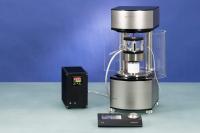Dynamic contact angle measurement

Dynamic contact angles
The contact angle is a parameter used to analyse the wetting behaviour of a liquid on a solid surface. The static contact angle describes the state in equilibrium. Dynamic contact angles describe a drop of liquid that is in motion. This means, for example, measuring as a drop rolls off a tilted solid surface.
A distinction is made between two dynamic contact angles. The advancing contact angle ΘAdv describes how a liquid drop wets a solid. In detail, it provides information on how the liquid drop wets a dry
solid surface area. The receding contact angle ΘRec characterises how the liquid detaches from a wet
solid surface area, i.e., dewets the solid.

Measuring dynamic contact angles
As soon as the dynamic contact angle reaches its limit values, the contact area between liquid drop and surface begins to change. This means that dynamic contact angles can be measured experimentally, using either optical or force-based methods.
Dynamic contact angles can be measured with a force-based tensiometer using the Wilhelmy method. The DataPhysics DCAT series instruments are based on this method.
The Wilhelmy plate method is a well-established method for determining surface and interfacial tensions with a tensiometer. The method utilises a Wilhelmy plate as the test body. It is typically made of iridium–platinum and is a few centimetres in length and height. The plate is attached to the weighing system of the tensiometer and positioned at the liquid surface in such a way that a liquid lamella forms. The gravitational force of the lamella, which equals the perpendicular part of the tensile force caused by the surface tension, is measured.
